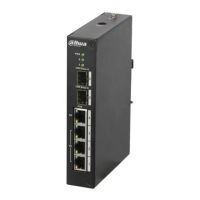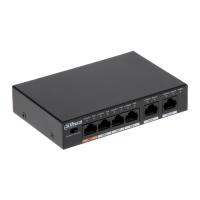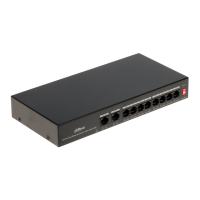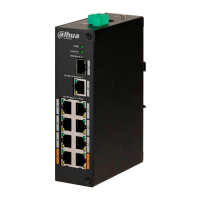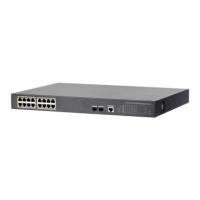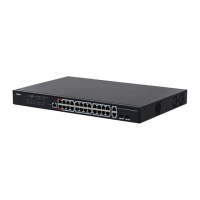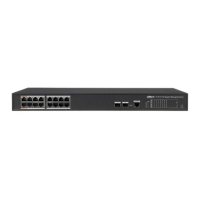Do you have a question about the Dahua DH-PFS6428-24T and is the answer not in the manual?
Explains entering and exiting switch operational modes.
Displays device name, software, hardware, MAC, and time.
Displays device, software, hardware, MAC, compile, and version info.
Displays the current system time and date.
Displays system logs for analysis.
Displays the current log entries of the switch.
Displays packet counts and errors per port.
Displays packet statistics for specified or all ports.
Displays LACP port configurations.
Displays the current status of the LACP system.
Displays switch routing information.
Displays detailed router information.
Displays ERPS information.
Displays the ERPS information for the device.
Displays power supply information.
Displays the power supply status of the switch.
Manages IP address settings for interfaces.
Configures static IP addresses for ports.
Configures ports to obtain IPs via DHCP.
Changes existing IP configurations on interfaces.
Displays the IP information of network interfaces.
Manages user accounts and access privileges.
Adds, modifies, or deletes user accounts.
Displays all current user configurations on the switch.
Configures system time and NTP synchronization.
Enables or disables the NTP client function.
Configures the IP address of the NTP server.
Sets the interval for NTP time synchronization.
Selects the NTP server to connect to.
Sets the system timezone.
Sets the system's local date and time.
Configures basic port operational parameters.
Sets the port's duplex mode (auto, full, half).
Configures the port's network speed.
Enables or disables flow control on ports.
Disables or enables a network port.
Configures a descriptive label for the port.
Configures speed limits for port traffic.
Sets ingress or egress speed limits for a port.
Monitors network traffic by copying packets.
Configures port mirroring sessions for traffic analysis.
Combines multiple ports into a logical link.
Configures static link aggregation.
Sets the load balancing mode for static aggregation.
Manages dynamic link aggregation using LACP.
Configures the LACP port's active or passive role.
Sets the management key for LACP aggregation.
Configures the priority for LACP ports.
Demonstrates link aggregation setup.
Manages Virtual LANs for network segmentation.
Configures the port's connection type (access, trunk, hybrid).
Assigns a default VLAN ID to untagged traffic.
Configures port VLAN tagging and membership.
Displays information about configured VLANs.
Illustrates VLAN communication setup.
Configures double VLAN tagging.
Enables or disables the QinQ feature.
Sets the outer tag protocol identifier for QinQ.
Manages MAC address learning and aging.
Configures the time before MAC entries expire.
Displays the MAC address table.
Manages Address Resolution Protocol entries.
Displays the ARP cache table.
Adds static ARP entries for fixed IP-MAC mappings.
Configures the aging time for ARP entries.
Configures Multiple Spanning Tree Protocol.
Enables or disables the Spanning Tree Protocol.
Sets the Spanning Tree Protocol version (STP, RSTP, MSTP).
Configures the maximum age for STP BPDUs.
Configures the hello message interval for STP.
Configures the STP forward delay timer.
Configures the maximum hop count for STP BPDUs.
Configures MSTP instances and VLAN mapping.
Sets the MSTP domain name.
Sets the MSTP configuration revision number.
Displays the Spanning Tree Protocol configuration.
Shows brief STP status for interfaces.
Restricts multicast traffic based on IGMP.
Enables or disables IGMP snooping.
Sets the aging time for IGMP host entries.
Enables immediate port leave for IGMP groups.
Adds static IGMP multicast groups.
Displays IGMP snooping group information.
Demonstrates IGMP snooping setup.
Manages IP address assignment via DHCP.
Enables or disables the DHCP server service.
Creates and configures DHCP address pools.
Defines IP address segments for DHCP pools.
Configures the default gateway for DHCP clients.
Configures the DNS server IP address.
Configures static IP-MAC bindings for DHCP.
Configures IP address lease duration.
Sets the DNS domain name for the server.
Configures the NetBIOS name server.
Illustrates DHCP server configuration.
Forwards DHCP requests to a server.
Configures an interface as a DHCP relay agent.
Enhances DHCP security by validating servers.
Enables or disables DHCP snooping globally.
Configures ports as trusted or untrusted for DHCP snooping.
Displays DHCP snooping lease information.
Quality of Service for traffic prioritization.
Changes the QoS trust mode for packets.
Sets the default Class of Service priority.
Configures port trust settings for QoS priority.
Maps Class of Service priorities to queues.
Maps Differentiated Services Code Point priorities to COS.
Sets QoS scheduling algorithms for queues.
Demonstrates QoS configuration.
Virtual Router Redundancy Protocol configuration.
Configures VRRP advertisement interval.
Sets the virtual router IP address.
Configures VRRP preemption mode.
Sets the VRRP preemption delay time.
Sets the priority for VRRP virtual routers.
Illustrates VRRP configuration scenario.
Configures Layer 3 virtual interfaces.
Enters interface configuration mode.
Enables or disables a VLAN interface.
Assigns or removes IP addresses from interfaces.
Displays IP information for interfaces.
Manually configures routing table entries.
Adds or deletes static routes.
Displays the static routing table.
Demonstrates static route setup.
Configures Open Shortest Path First routing.
Enables the OSPF routing process.
Declares OSPF networks and areas.
Sets the unique identifier for the OSPF router.
Configures SPF calculation timers.
Sets the default metric for OSPF routes.
Configures default passive interfaces for OSPF.
Imports routes from other protocols into OSPF.
Generates default OSPF routes.
Configures OSPF interface attributes.
Displays OSPF routing information.
Illustrates OSPF setup.
Configures Border Gateway Protocol routing.
Enables the BGP routing process.
Configures BGP update and aging timers.
Imports routes from other protocols into BGP.
Configures BGP neighbor relationships.
Declares networks for BGP advertisement.
Demonstrates BGP configuration scenario.
Configures Routing Information Protocol.
Generates default RIP routes.
Sets the default metric for RIP routes.
Configures administrative distance for RIP.
Exits the current RIP configuration mode.
Exits the current configuration mode.
Defines RIP routing segments.
Filters RIP routes based on offset.
Configures interfaces as passive for RIP.
Imports routes from other protocols into RIP.
Configures RIP update and garbage collection timers.
Sets the RIP protocol version.
Demonstrates RIP configuration.
Configures defenses against network attacks.
Ignores ICMP echo requests.
Protects against SYN flood attacks.
Controls CPU usage from network traffic.
Binds MAC addresses to ports.
Adds static MAC address bindings.
Controls network access using IP-MAC bindings.
Enables/disables IP-MAC binding globally or per port.
Displays IP-MAC binding information.
Configures Access Control Lists for traffic filtering.
Creates MAC-based Access Control Lists.
Creates IP-based Access Control Lists.
Defines specific rules within an ACL.
Applies ACLs to interfaces.
Implements port-based network access control.
Enables or disables the 802.1X authentication globally.
Configures RADIUS authentication server details.
Sets the authentication server type (local/remote).
Configures accounting server details for 802.1X.
Configures authentication timer parameters.
Sets the port authentication mode (forced, auto, unauthorized).
Configures 802.1X based on MAC or port.
Configures authentication aging time.
Creates new user accounts for authentication.
Isolates ports within the same VLAN from each other.
Enables port isolation protection.
Limits excessive network traffic on ports.
Controls broadcast storm traffic rates.
Controls multicast storm traffic rates.
Controls unicast storm traffic rates.
Ethernet Ring Protection Switching configuration.
Enables loop protection functionality.
Configures loop-protection transmit time.
Enables or disables loop-protection transmit.
Displays loop-protection status.
Demonstrates ERPS loop protection.
Ethernet Ring Protection Switching configuration.
Enables or disables ERPS globally.
Configures specific ERPS ring parameters.
Displays ERPS ring status.
Demonstrates ERPS ring setup.
Filters packets to prevent unauthorized access.
Enables or disables the IP source guard feature.
Configures the trust level for dynamic clients.
Binds IP and MAC addresses using DHCP snooping.
Displays IP source guard lease information.
Configures HTTP/HTTPS services on the switch.
Enables the HTTP service on the switch.
Enables the HTTPS service on the switch.
Configures Simple Network Management Protocol.
Enables or disables SNMP globally.
Configures the SNMP trap receiver address.
Enables or disables SNMP traps.
Configures SNMP community strings and permissions.
Configures the SNMP system hostname.
Configures SNMP user accounts.
Demonstrates SNMP configuration.
Restarts the network device.
Performs a system restart.
Resets the device to factory default settings.
Restores the switch to its factory default state.
Manages switch configuration files.
Saves the current switch configuration.
Tests network connectivity using the ping utility.
Checks reachability between the switch and a host.
